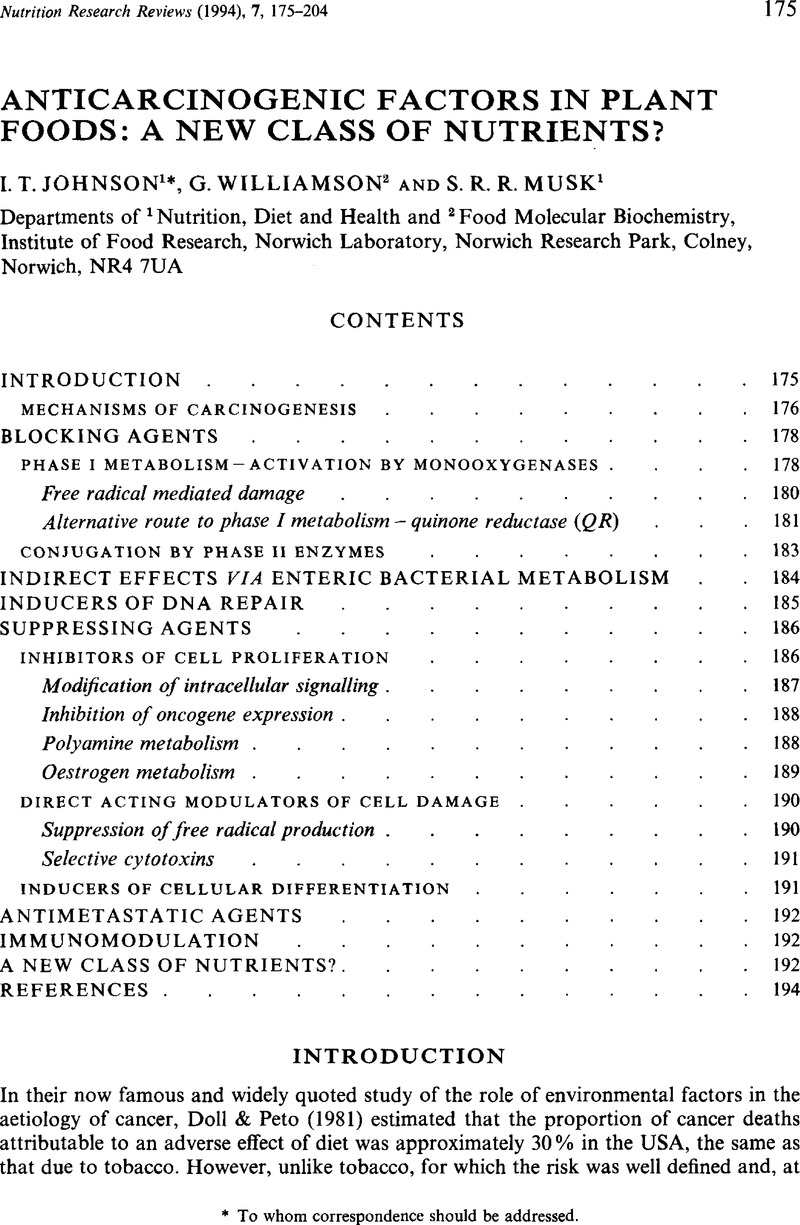Crossref Citations
This article has been cited by the following publications. This list is generated based on data provided by Crossref.
Musk, Stephen R. R.
Stephenson, Pauline
Smith, Tracy K.
Stening, Peter
Fyfe, Daren
and
Johnson, Ian T.
1995.
Selective toxicity of compounds naturally present in food toward the transformed phenotype of human colorectal cell line HT29.
Nutrition and Cancer,
Vol. 24,
Issue. 3,
p.
289.
Rhodes, M. J. C.
1996.
Physiologically-active compounds in plant foods: An overview.
Proceedings of the Nutrition Society,
Vol. 55,
Issue. 1B,
p.
371.
Lambert, Nigel
Chambers, Stephen J.
Plumb, Geoffrey W.
and
Williamson, Gary
1996.
Human Cytochrome P450′ are Pro-oxidants in Iron/Ascorbate-Initiated Microsomal Lipid Peroxidation.
Free Radical Research,
Vol. 24,
Issue. 3,
p.
177.
Johnson, I. T.
Southgate, D. A.T.
and
Durnin, J. V.G.A.
1996.
Intrinsic and non-milk extrinsic sugars: Does the distinction have analytical or physiological validity?.
International Journal of Food Sciences and Nutrition,
Vol. 47,
Issue. 2,
p.
131.
Williamson, Gary
1996.
Protective effects of fruits and vegetables in the diet.
Nutrition & Food Science,
Vol. 96,
Issue. 1,
p.
6.
Halliwell, Barry
1996.
Commentary Oxidative Stress, Nutrition and Health. Experimental Strategies for Optimization of Nutritional Antioxidant Intake in Humans.
Free Radical Research,
Vol. 25,
Issue. 1,
p.
57.
PLUMB, GEOFFREY W.
CHAMBERS, STEPHEN J.
LAMBERT, NIGEL
BARTOLOMÉ, BEGONA
HEANEY, ROBERT K.
WANIGATUNGA, SU
ARUOMA, OKEZIE I.
HALLIWELL, BARRY
and
WILLIAMSON, GARY
1996.
ANTIOXIDANT ACTIONS OF FRUIT, HERB AND SPICE EXTRACTS.
Journal of Food Lipids,
Vol. 3,
Issue. 3,
p.
171.
Chambers, Stephen J.
Lambert, Nigel
Plumb, Geoffrey W.
and
Williamson, Gary
1996.
Evaluation of the antioxidant properties of a methanolic extract from ‘Juice Plus fruit’ and ‘Juice Plus vegetable’ (dietary supplements).
Food Chemistry,
Vol. 57,
Issue. 2,
p.
271.
Plumb, Geoffrey W.
Lambert, Nigel
Chambers, Stephen J.
Wanigatunga, Su
Heaney, Robert K.
Plumb, Jenny A.
Aruoma, Okezie I.
Halliwell, Barry
Miller, Nicholas J.
and
Williamson, Gary
1996.
Are Whole Extracts and Purified Glucosinolates from Cruciferous Vegetables Antioxidants?.
Free Radical Research,
Vol. 25,
Issue. 1,
p.
75.
Pool‐Zobel, B. L.
Neudecker, C.
Domizlaff, I.
Ji, S.
Schillinger, U.
Rumney, C.
Moretti, M.
Vilarini, I.
Scassellati‐Sforzolini, R.
and
Rowland, I.
1996.
Lactobacillus‐ and bifidobacterium‐mediated antigenotoxicity in the colon of rats.
Nutrition and Cancer,
Vol. 26,
Issue. 3,
p.
365.
Williamson, Gary
DuPont, M.Susan
Wanigatunga, Su
Heaney, Robert K.
Musk, Stephen R.R.
Fenwick, G.Roger
and
Rhodes, Michael J.C.
1997.
Induction of glutathione S-transferase activity in hepG2 cells by extracts from fruits and vegetables.
Food Chemistry,
Vol. 60,
Issue. 2,
p.
157.
Rosa, Eduardo A.S.
1997.
Glucosinolates from flower buds of Portuguese Brassica crops.
Phytochemistry,
Vol. 44,
Issue. 8,
p.
1415.
Ferguson, LR
1997.
Micronutrients, dietary questionnaires and cancer.
Biomedicine & Pharmacotherapy,
Vol. 51,
Issue. 8,
p.
337.
Aruoma, Okezie I.
Deiana, Monica
Jenner, Andrew
Halliwell, Barry
Kaur, Harparkash
Banni, Sebastiano
Corongiu, Francesco P.
Dessí, M. Assunta
and
Aeschbach, Robert
1998.
Effect of Hydroxytyrosol Found in Extra Virgin Olive Oil on Oxidative DNA Damage and on Low-Density Lipoprotein Oxidation.
Journal of Agricultural and Food Chemistry,
Vol. 46,
Issue. 12,
p.
5181.
Lee, Eunyong
and
Surh, Young-Joon
1998.
Induction of apoptosis in HL-60 cells by pungent vanilloids, [6]-gingerol and [6]-paradol.
Cancer Letters,
Vol. 134,
Issue. 2,
p.
163.
Halliwell, Barry
1998.
Can oxidative DNA damage be used as a biomarker of cancer risk in humans? Problems, resolutions and preliminary results from nutritional supplementation studies.
Free Radical Research,
Vol. 29,
Issue. 6,
p.
469.
Halliwell, B.
1998.
Oxidative Stress in Skeletal Muscle.
p.
1.
Halliwell, Barry
1999.
Oxygen and nitrogen are pro-carcinogens. Damage to DNA by reactive oxygen, chlorine and nitrogen species: measurement, mechanism and the effects of nutrition.
Mutation Research/Genetic Toxicology and Environmental Mutagenesis,
Vol. 443,
Issue. 1-2,
p.
37.
Surh, Young-Joon
1999.
Molecular mechanisms of chemopreventive effects of selected dietary and medicinal phenolic substances.
Mutation Research/Fundamental and Molecular Mechanisms of Mutagenesis,
Vol. 428,
Issue. 1-2,
p.
305.
Jhonson, Ian
1999.
Antioxydants et anticancéreux.
Biofutur,
Vol. 1999,
Issue. 186,
p.
14.



